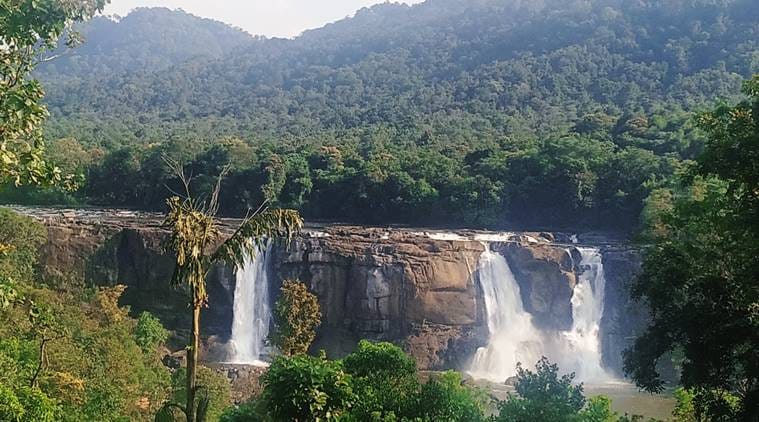 The dam was proposed to be built a few kilometres upstream of the Athirappilly waterfalls, a major tourist attraction in the state
The dam was proposed to be built a few kilometres upstream of the Athirappilly waterfalls, a major tourist attraction in the state
In a major upset for conservationists, Opposition parties and also its own allies, Kerala’s CPM-led government formally approved the much-contested Athirappilly hydel power project across the Chalakudy River.
The power department gave a no-objection certificate (NOC) to the Kerala State Electricity Board (KSEB), which has to execute the project, so that the latter could apply for fresh financial, technical and environmental clearances.
“The government has said that it is not opposed to the KSEB’s application to go ahead with the project and seek a fresh environmental clearance” said a top official.
The project, murmurs of which began in the early 80s, involves building a dam across the Chalakudy River in the Athirappilly panchayat in Thrissur district to generate 163MW of power mainly to tide over the power deficit in the state.
The dam was proposed to be built a few kilometres upstream of the Athirappilly waterfalls, a major tourist attraction in the state. However, the project was opposed tooth and nail by the local panchayat, environmentalists, political parties like the CPI and tribal groups on grounds that it would cause irrevocable damage to the river system, the surrounding forest areas, the rich biodiversity and the human settlements there. Every time a government in office proceeded to undertake clearances for the project, protests and agitations rang out across the state.
Perhaps no environmental issue has kicked as much furore as the proposed dam in Athirappilly. And it is in this context that the current Left dispensation’s move to initiate proceedings once again on the project has caused alarm among environmentalists and its own ruling partners.
In 2018, Power Minister MM Mani had publicly admitted that the government could not go ahead with the project as it lacked consensus among Opposition parties like the Congress and even leaders of its own ruling ally – the CPI. The U-turn now on the part of the government is, therefore, circumspect.
Senior CPI leader and Rajya Sabha MP Binoy Viswam maintained that his party remained strongly opposed to the hydel power project.
“That decision in 2018 was taken after due consultations within the LDF (Left Democratic Front) and after studying all sides. Therefore, a change in that decision without discussing the matter at any forum of the LDF is not reflective of the politics and culture of the LDF,” he said.
“When the project was first mooted in 1979, the idea was to generate 163MW power from the river water. Today, there isn’t enough water in the river to generate the same power. That’s the big change in the last 41 years. To not accept it is neither common sense nor science. The costs have escalated too.” He questioned why the government was moving to implement a project that would cause untold environmental damage.
“178 hectares of pristine forest area would be destroyed. A river will be killed and the lives of tribals living in the area would be tossed aside. It (project) cannot go on,” Viswam said.
Senior Congress leader and former environment minister Jairam Ramesh tweeted, “By approving Athirapally hydel project despite opposition and expert advice, Kerala govt is inflicting ecological disaster. Indira Gandhi saved Western Ghats by stopping the Silent Valley project in 1983. That commitment, concern and courage (3Cs) for environment is missing today.”
Concerns among environmentalists regarding the proposed dam were substantiated by the Western Ghats Ecology Expert Panel (WGEEP) chaired by Prof Madhav Gadgil which held wide consultations among local residents, activist groups and key stakeholders behind the project. Its report recommended that no new dams based on large-scale storage be permitted in ecologically sensitive zone 1 (ESZ1) as defined by the panel. Athirappilly, among others, fell in ESZ1.
It noted the key biodiversity strengths of the region around the Chalakudy river in Athirappilly including 155 species of endemic plants, critically-endangered riparian trees and unique bird and fish species which would be lost if the dam became a reality. Additionally, there would be a ‘complete alteration of the ecology of the river systems’, impact on the availability of water in panchayats downstream of the river and loss of habitat for the primitive Kadar tribe. Based on these findings, the WGEEP report recommended to the Centre not to give permission for the proposed dam and to protect Athirappilly-Vazhachal as such.
Chandrika Shibu, a ward member of the Athirappilly panchayat belonging to the CPI(M), said there have been no discussions within the local body after the latest government nod for the project. But she added that she was vehemently opposed to it.
“The standing committee is likely to meet soon so the issue will come up,” she said.
CR Neelakandan, prominent environmental activist, remarked that he was 100 per cent confident the project will not become a reality.
“It is very difficult for the project to get an environmental clearance. The environment impact assessment (EIA) studies have been dismissed in the past, even by the High Court. The project will not only bring ecological losses, but it will also be an economic failure. At a time when alternative energy sources like solar are available, building a large dam is a remote possibility,” he said.
As to what the government’s latest sanction could mean, he said: “For a state that underwent back-to-back floods, it’s surprising how the government could take such a decision. After the floods, the government had said that it would be very careful, but we cannot see any policy changes.”
“So this could be a move to satisfy a few contractor lobbies. Or it could be a diversionary tactic to take the attention away from real issues. This may enrage the people and the activists, but in its shadow, a few negative projects may get cleared,” he added.